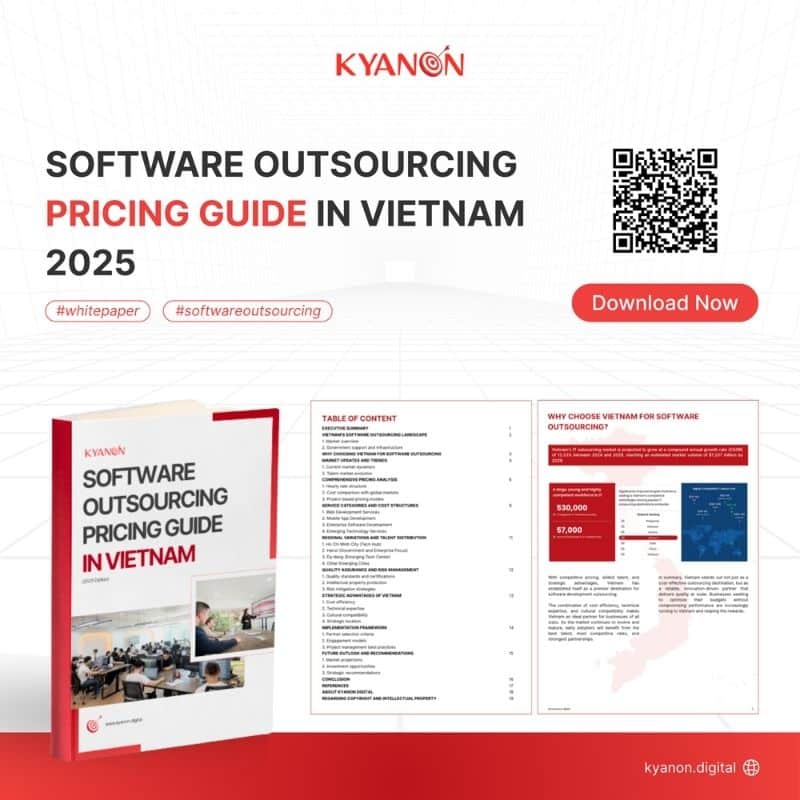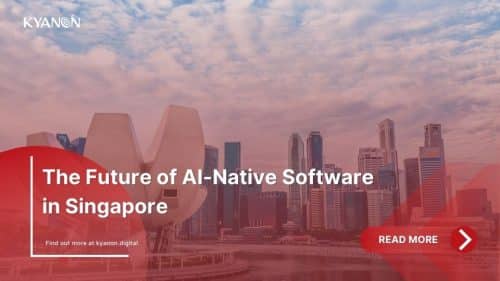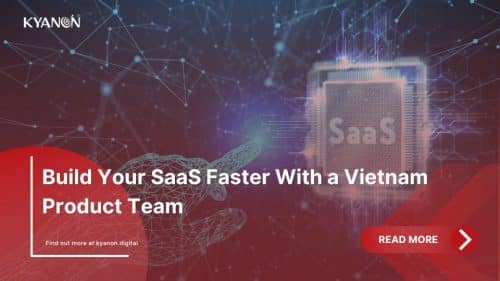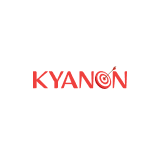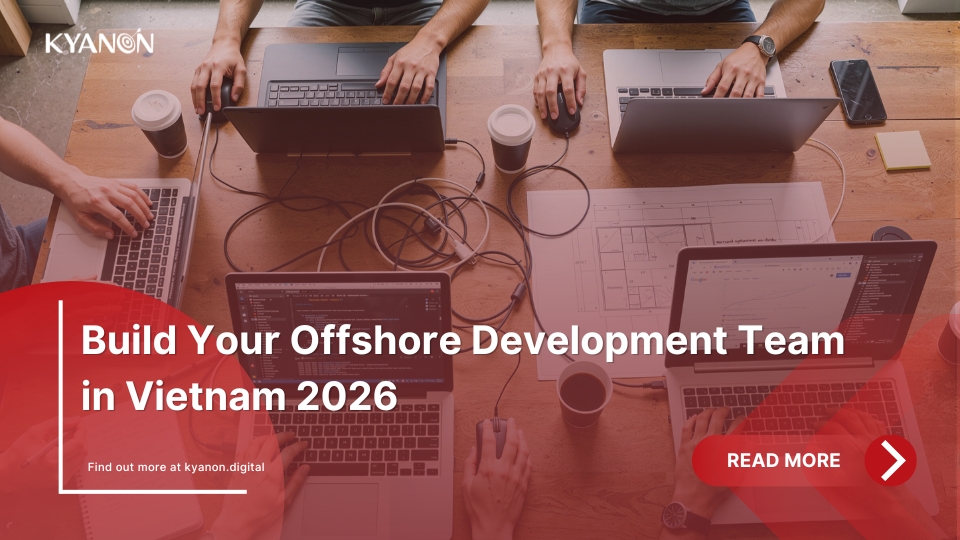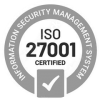In today’s fast-evolving digital landscape, the demand for skilled tech professionals has never been higher. Businesses worldwide are grappling with a significant IT talent shortage that threatens to delay innovation, inflate operational costs, and hinder digital transformation efforts. From cloud engineers to AI specialists, the race to secure top-tier tech talent is intensifying, leaving many companies struggling with critical skill gaps.
According to a 2023 internal McKinsey survey of 40 executives across various industries, only 16% felt confident in having sufficient technology talent to support their digital transformation efforts. Meanwhile, 60% of respondents identified the shortage of tech talent and skills as a major barrier to progress.
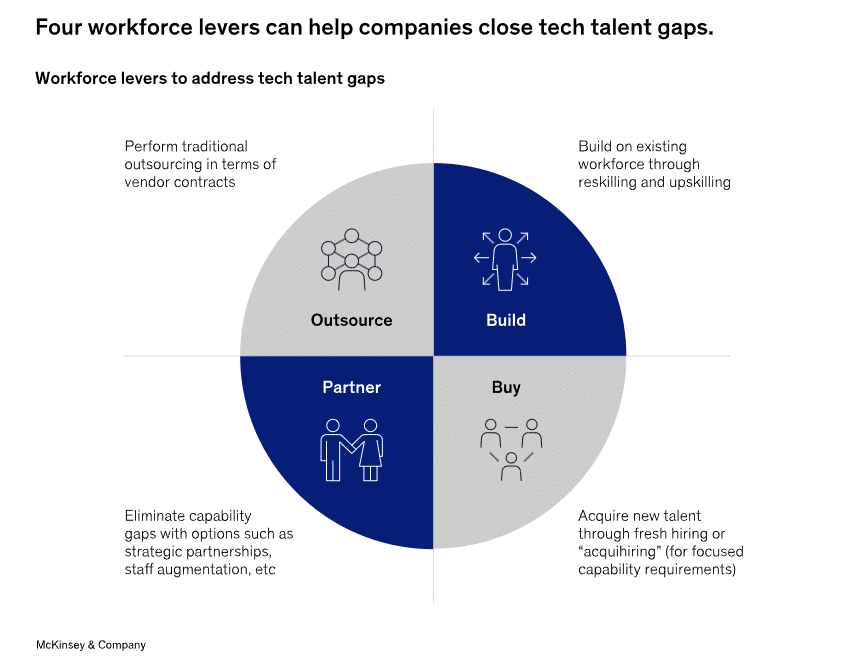
Four workforce levers can help companies close tech talent gaps (Source: McKinsey & Company)
Deloitte reports that executives are finding it increasingly difficult to fill critical technical roles such as AI specialists, cybersecurity professionals, and system architects. Meanwhile, the IMF projects that the global tech talent shortage could grow to over 85 million workers by 2030, a gap that may result in more than $8 trillion in lost annual revenue.
In this article, Kyanon Digtial will guide business and technology leaders on how to effectively identify and address those gaps through a flexible and strategic workforce solution: IT staff augmentation. By understanding the staff augmentation process, organizations can gain the agility needed to scale teams quickly and stay competitive in a volatile market.
What is IT staff augmentation?
IT staff augmentation meaning refers to a hiring model where companies temporarily add external tech talent to their existing teams to address skills shortages. Rather than going through lengthy recruitment cycles or committing to long-term hires, organizations can quickly onboard skilled professionals on-demand, whether for a few months or the duration of a specific project.
This approach has become a core component of modern workforce strategies, especially in the tech sector where agility and speed are crucial. By leveraging IT staff augmentation, businesses gain access to a global talent pool, reduce time-to-hire, and maintain control over project management and internal workflows. It enables companies to scale their teams up or down based on current needs, without sacrificing productivity or project momentum.

Whether you’re launching a new digital product, migrating to the cloud, or enhancing cybersecurity infrastructure, the staff augmentation process offers the flexibility to fill immediate talent gaps while optimizing costs and outcomes.
Key stages of the IT staff augmentation process
STEP 01: Define your needs
Identify the specific skills and expertise required for your project. Determine the number of developers, their roles, and the technologies they should be proficient in. Clearly outline the experience level you expect for each role to ensure the team aligns with your project goals.
STEP 02: Research vendors
Look for vendors specializing in dedicated team services. Evaluate their experience, talent pool, and ability to scale the team based on your needs. Check client reviews, case studies, and certifications such as ISO 9001 (quality management) and ISO 27001 (data security) to assess reliability.
Consider the team’s location based on factors like time zone compatibility, language proficiency, and legal regulations. Nearshore or offshore options can provide access to skilled professionals while optimizing costs.
STEP 03: Request proposals
Share your team requirements with shortlisted vendors, including:
- The number of developers and their roles
- Required technical expertise and experience levels
- Expected duration of engagement
- Budget and flexibility for scaling the team
- Request details on the vendor’s hiring process, team availability, and pricing structure.
STEP 04: Interview key team members
Once the vendor provides candidate profiles, interview key team members such as tech leads or senior developers to assess their skills, communication abilities, and alignment with your company culture. For other roles, rely on the vendor’s internal selection and vetting process to save time. You may also assign test tasks or start with a short trial period to validate capabilities.
STEP 05: Negotiate the contract
Since you control the team’s tasks and priorities, the contract should focus on:
- Team composition and flexibility to scale
- Pricing model (e.g., fixed monthly rate per developer)
- Confidentiality, intellectual property rights, and security agreements
- Performance expectations, availability, and communication protocols
Service Level Agreements (SLAs) should outline response times, quality standards, and reporting structures.
STEP 06: Onboard and integrate the team
Once hired, ensure a smooth onboarding process by:
- Providing access to necessary tools, repositories, and documentation
- Setting up communication channels (Slack, Jira, GitHub, etc.)
- Defining workflows, reporting structures, and regular check-ins
- Facilitating knowledge transfer and collaboration with your internal team
By following these key stages, from assessing talent needs to onboarding and managing augmented staff, organizations create a streamlined, scalable staffing strategy. This process empowers companies to respond quickly to shifting project demands, embrace emerging technologies, and stay competitive in fast-moving markets.
With the flexibility to scale talent up or down as needed, IT staff augmentation becomes a powerful enabler of organizational agility and continuous innovation.
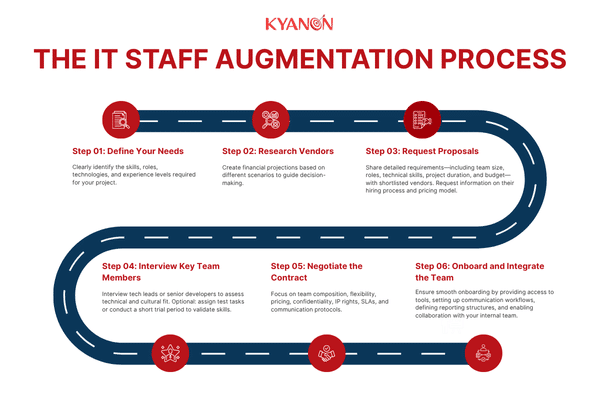
Transform your ideas into reality with our services. Get started today!
Our team will contact you within 24 hours.
How to identify talent gaps in your IT team
Before leveraging IT Staff Augmentation, organizations must first accurately identify the gaps in their internal IT capabilities. A talent gap is not just a missing headcount, it’s a critical disconnect between your current team’s skills and the competencies required to achieve business and technical objectives. By diagnosing these gaps, businesses can deploy a tailored staff augmentation process to fill them efficiently and strategically.
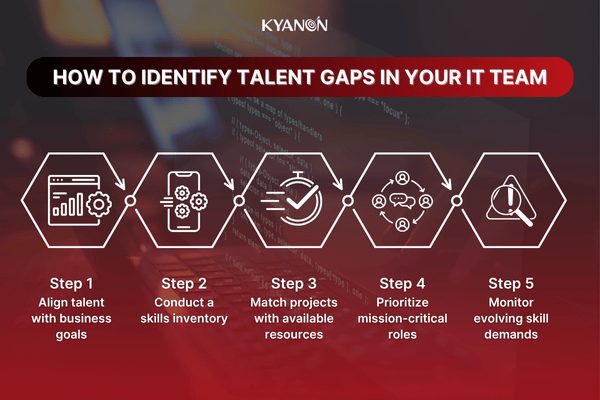
Step 1: Align talent with business goals
Begin by aligning your workforce with strategic business initiatives. For instance, if your company plans to implement AI-based features or migrate infrastructure to the cloud, you’ll need specialists in machine learning, data engineering, or cloud architecture. However, most companies don’t have these skills in-house.
According to McKinsey, 87% of companies worldwide say they are already experiencing talent gaps or expect to in the next few years, particularly in cloud, cybersecurity, and advanced analytics.
Step 2: Conduct a skills inventory
Carry out a comprehensive audit of your current team’s skills. Tools like LinkedIn Skills Assessments, internal surveys, or performance data can help uncover both strengths and weaknesses. For example, a fintech company might discover that while their developers are strong in backend Java, they lack React Native expertise needed for a new mobile product.
Step 3: Match projects with available resources
Compare your IT roadmap with your team’s current workload. Are deadlines being missed? Are senior engineers being pulled into entry-level tasks due to resource constraints?
Gartner reports that 64% of IT leaders say talent shortage is the most significant barrier to adopting emerging technologies.
Step 4: Prioritize mission-critical roles
Not every gap requires urgent attention. Focus on key areas that directly impact your bottom line, such as:
- Software developers during product launches
- QA testers during scaling phases
- DevOps and cloud engineers during infrastructure transitions
Step 5: Monitor evolving skill demands
The tech landscape evolves rapidly and so should your team. Emerging roles in AI, blockchain, cybersecurity, and data science are increasingly in demand.
A LinkedIn Workforce Report revealed that the demand for cybersecurity talent significantly increased YoY in 2023, while the supply remained stagnant.
Strategies for effectively addressing skill gaps with IT staff augmentation
Now that you’ve identified where the talent gaps are, the next step is implementation, bringing in the right resources at the right time using IT Staff Augmentation. This flexible model empowers companies to stay competitive, boost innovation, and accelerate time-to-market without the delays and overhead of traditional hiring.
Below are proven strategies to help you execute a successful staff augmentation process, optimize your resource allocation, and convert skill gaps into strategic advantages.
1. Align staff augmentation with business goals
The first rule of successful IT staff augmentation is clarity. You must align your staffing decisions with broader business objectives. Start by asking:
- Does the gap impact revenue, innovation, compliance, or speed to market?
- Which roles are most critical to delivering your core products or services?
Prioritize roles that directly affect your digital transformation goals, customer experience, or regulatory compliance. This ensures that every dollar spent on IT staff augmentation contributes measurable value to your business.
2. Choose the right staff augmentation model
Understanding the staff augmentation meaning isn’t just about hiring external talent – it’s about choosing the right model based on your needs.
| Category | Dedicated Team | Team Augmentation | Full Project Outsourcing |
| Full Project Outsourcing | – Best for long-term projects needing continuous updates and support.
– Useful when you need experts to handle part of an ongoing project. |
– When you need extra developers to fill skill gaps.
– Helps meet deadlines by adding resources. |
Ideal when you need a full software solution but lack internal IT resources to manage it. |
| Example Projects | A SaaS company that needs regular updates hires a dedicated team to maintain and improve its platform | An e-commerce business adds extra developers during peak shopping seasons to handle high traffic and launch new features. | A healthcare provider without an internal IT team outsources the development of a custom EHR system to a software company. |
| Cost Considerations | Higher upfront costs but more cost-effective over time due to the team’s deep understanding of the project. | Costs vary based on demand; ideal for short-term or fluctuating needs. | Lower initial cost, but total expenses may rise if changes or extra features are required after delivery. |
| Risk Sharing | Both the company and vendor share risks. The company controls the team, while the vendor handles admin tasks. | The company takes on most of the risk, managing the project while the vendor provides extra staff. | The vendor is fully responsible for the project, but the company risks working with an unreliable vendor. |
| Team Integration | – The team works closely with your company’s processes and tools.
– Dedicated team ensures better communication. – Greater retention of knowledge and expertise. |
– New staff need time to adjust and integrate.
– Temporary workers may struggle to fully adapt to your workflows. |
Minimal integration with your internal team and development processes. |
| Project Management | – The vendor manages the team but keeps you updated regularly.
– Some project coordination may still be required on your side. |
You handle most management tasks, including assigning work, setting priorities, tracking progress, and ensuring quality. | – Minimal management required.
– The vendor is responsible for delivering the project on time and meeting quality standards, with penalties for delays. |
Comparing Team Augmentation to Dedicated Teams and Full Project Outsourcing
Choosing the right model helps minimize costs, maximize output, and tailor your staff augmentation process to fit your organizational culture and technical stack.
3. Define clear roles and expectations
A common pitfall in staff augmentation is a lack of clarity. Ensure success by:
- Creating detailed job descriptions, including required skills, tech stack, responsibilities, and KPIs.
- Establishing clear reporting structures, communication protocols, and project ownership.
- Outlining expected outcomes and timelines from the start.
Mistake to Avoid: Onboarding developers without specifying who reviews their code or how progress will be tracked leads to inefficiencies and missed deadlines.
When everyone knows their role and expectations, collaboration becomes frictionless, even across time zones and cultures.
4. Optimize the onboarding process
Accelerate productivity by standardizing the onboarding experience for augmented staff. A strong onboarding process reduces ramp-up time and improves engagement.
- Provide checklists that cover account access, tool configuration (Jira, GitHub, Slack), and documentation.
- Host a kickoff session to introduce your augmented staff to project stakeholders and internal workflows.
- Share insights into company culture, communication style, and decision-making processes.
5. Foster team integration
One of the biggest misconceptions about staff augmentation is that augmented staff are “outsiders.” In reality, their performance depends heavily on how well they are integrated into your core team.
- Include augmented professionals in daily standups, sprint planning, and retrospectives.
- Assign mentors or technical leads to provide guidance and ensure alignment with your coding standards and workflows.
- Use collaboration tools like Slack, Notion, and Confluence to create a shared knowledge base.
Pro Tip: Treat augmented talent as an extension of your in-house team, not as third-party contractors. This improves collaboration, trust, and long-term retention.
6. Track performance and outcomes
You can’t manage what you don’t measure. Use data-driven performance tracking to ensure your IT staff augmentation investment is delivering returns.
- Set measurable KPIs (e.g., sprint velocity, bug fix rate, code quality) and OKRs tied to project milestones.
- Schedule regular reviews to assess both individual performance and skill fit.
- Continuously evaluate whether additional or different skills are needed as the project evolves.
What to look for in an IT staff augmentation provider
Once you’ve aligned your business goals and defined the staff augmentation strategy, the next and arguably most crucial, step is selecting the right IT staff augmentation partner. A strong partnership can drive your project forward efficiently and cost-effectively. A poor choice, on the other hand, can lead to delays, mismatched skills, and unmet expectations.
Not all vendors are created equal. The right partner must go beyond just supplying tech talent, they should function as a strategic extension of your organization.

1. Proven talent pool and technical expertise
Look for providers with deep experience in your industry or technology stack. Domain knowledge ensures that augmented staff understand your business logic, regulatory landscape, and customer expectations.
Example: A healthcare startup chose a partner with prior experience in HIPAA-compliant systems. The augmented developers were productive from day one, accelerating delivery without compromising data security.
2. Quality of talent pool
Evaluate the staff augmentation meaning in terms of access to high-quality, pre-vetted talent. A mature vendor should offer professionals who are not only technically skilled but also adaptable, communicative, and collaborative.
- What is their recruitment and vetting process?
- Do they support both niche and general IT roles?
- Can they scale teams quickly without sacrificing quality?
3. Transparent and agile staff augmentation process
A successful staff augmentation process should be transparent, flexible, and aligned with your internal workflows. Ask about how the provider sources, screens, and integrates their candidates. Ideally, they should:
- Understand your project requirements thoroughly
- Present pre-vetted candidates quickly
- Allow you to interview and choose the best fit
- Provide support for onboarding and ongoing collaboration
This agile process minimizes friction and accelerates time-to-productivity.
4. Reputation and client references
Check the provider’s reputation through case studies, client testimonials, and independent reviews. An established provider should be able to showcase successful IT staff augmentation stories, preferably in your industry or technology domain.
Don’t hesitate to ask for client references or to verify their past work through platforms like Clutch or LinkedIn.

Client’s feedbacks on Clutch profile of Kyanon Digital
Choosing the right IT staff augmentation partner

We’re a Tech Partner, Not a Recruiter
We build your team strategically, aligning talents with your software vision and roadmap, not just job requirements. With ongoing upskilling and expert support from our Center of Excellence, your talent stays ahead of challenges and delivers results.
Comprehensive Talent Ecosystem
Kyanon Digital talent ecosystem encompasses over 50,000 technology professionals
- Internal Talent Core: 500+ professionals
- K-Fresh Program: Nurturing Future Digital Leaders from 18 Universities in Vietnam
- External Talent Network: 15,000+ premium candidates
- Partner Network: 1,000+ trusted partners
Your One-Stop Talents Impact Solution
We manage from talent acquisition to HR management for your tech workforce, freeing your team to focus on core business and innovation.
Benefits of IT Staff Augmentation
By hiring Kyanon Digital engineering teams, you benefit from:
- Access to top-tier tech talent: As a tech company, we know how to hire the right engineers, and with support from our Center of Excellence, our talent is empowered to deliver exceptional results.
- Flexible cooperation due to easy team scaling (from 0.5 FTE to 30+ FTE).
- Fast ramp-up of the outsourced team (2 days – 2 weeks) due to robust team assembling practices.
- Up to 40% higher development speed due to mature software engineering and project management practices.

Conclusion
Understanding the IT staff augmentation meaning goes far beyond simply hiring external developers or tech experts. At its core, staff augmentation is a strategic approach that allows businesses to bridge skill gaps, scale development teams, and accelerate project delivery without the long-term commitments of traditional hiring. By leveraging on-demand tech talent, companies can stay agile, cost-effective, and competitive, especially in today’s fast-evolving digital environment.
If you’re looking for a trusted partner to help scale your development capabilities, Kyanon Digital is here to support you. With deep expertise in IT staff augmentation, we provide top-tier tech talent tailored to your business needs.
Contact Kyanon Digital today to build your flexible, future-ready team.
Key Takeaways
- Identifying talent gaps starts with a thorough analysis of your current team’s capabilities versus your business goals. Look for missing technical skills, bandwidth limitations, or expertise required for new projects.
- The staff augmentation process includes assessing internal gaps, defining role requirements, selecting the right augmentation partner, and ensuring smooth collaboration between internal and augmented teams.
- Staff augmentation helps you access specialized skills such as AI, ML, cloud, or cybersecurity, especially when those capabilities are hard to hire locally.
- With the right partner, IT staff augmentation empowers your business to stay competitive, innovate faster, and adapt to evolving technology needs.
References
- Tech talent gap: Addressing an ongoing challenge, McKinsey & Company
- Tech talent is still hard to find, despite layoffs in the sector, Deloitte
- Tech talent tectonics: Ten new realities for finding, keeping, and developing talent, McKinsey & Company
- IT Executives Cited Lack of Talent Ahead of implementation Cost and Security Risks, Gartner
- Hiring Amid Cybersecurity’s Rapid Growth & Talent Shortage!, PeopleLogic
Get the Vietnam Software Outsourcing Pricing Guide 2025
Your shortcut to Vietnam’s outsourcing costs and key market insights.

Why work with Kyanon Digital?
- Expertise Trusted by Fortune 500 Clients
With deep experience serving Fortune 500 companies, we deliver tailored, high-impact solutions that meet the unique demands of global enterprises. - A World-Class IT Team
Our 500+ IT experts—spanning consulting, project management, technical architecture, software engineering, QA, DevOps, and AI/ML—are committed to excellence in every project. - Quality at the Core
Certified under ISO 9001, our quality-first approach guarantees precision, reliability, and continuous improvement. - Uncompromising Security
ISO 27001-certified, we integrate robust security into every process, leveraging advanced technologies to protect your data against evolving threats.



